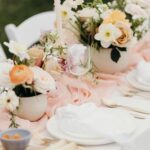Decorating a cake with different colors can take your baking to the next level, transforming a simple dessert into a visually stunning work of art. Whether it’s for a birthday, wedding, or any special occasion, the right color palette and techniques can elevate the overall look and appeal of your creation.
In this article, we will explore the different methods and tools needed to decorate a cake with different colors and provide step-by-step guidance on achieving professional-looking results.
When it comes to cake decoration, selecting the right color palette is essential in setting the tone for your creation. From choosing the perfect color combination that suits the occasion to understanding the principles of color theory in cake decoration, we’ll discuss everything you need to know about creating visually appealing designs. Additionally, we will delve into preparing the frosting and achieving the desired consistency for each color to ensure seamless application.
In addition to discussing techniques for using piping bags and creating ombre or gradient effects on your cake, we will also explore how to add texture with different colors using various design techniques. Finally, we’ll cover the use of edible decorations to enhance the color palette of your cake and address common issues when decorating with different colors while providing troubleshooting tips for a flawless finish. Ready to turn your baking into an art form? Let’s dive in.
Selecting the Right Color Palette
When it comes to decorating a cake with different colors, choosing the right color palette is essential in creating a visually appealing and harmonious design. Whether it’s for a birthday, wedding, or any special occasion, the colors used can greatly impact the overall look of the cake.
One tip for selecting the right color combination is to consider the theme and purpose of the cake. For instance, pastel colors may be suitable for a baby shower cake, while bold and vibrant colors could work well for a fiesta-themed celebration.
Understanding color theory is also crucial when selecting a color palette for cake decoration. Complementary colors can create eye-catching contrasts, while analogous colors can offer a more harmonious and unified look. It’s important to consider how different colors will interact with each other to achieve the desired effect on the cake.
In addition to considering the occasion and color theory, it’s also helpful to gather inspiration from various sources such as nature, fashion trends, or even art and design websites. This can give you fresh ideas and help you make informed decisions when choosing the right color palette for your cake decoration project. By taking these factors into account, you can ensure that your cake will not only taste delicious but also look stunning with its carefully selected color palette.
Preparing the Frosting
When it comes to decorating a cake with different colors, the frosting plays a crucial role in achieving the desired look. Here are some steps and tips on how to prepare different colored frosting for your cake:
1. **Choose the right food coloring:** Whether you’re using gel or liquid food coloring, it’s important to select high-quality products to achieve vibrant and consistent colors. Gel food coloring is preferred for achieving deeper shades, while liquid food coloring is great for lighter pastel colors.
2. **Create a base frosting:** Start by preparing a batch of white or vanilla frosting as your base. This will serve as the foundation for creating different colored frostings.
3. **Mixing in the colors:** Once you have your base frosting ready, divide it into separate bowls depending on how many different colors you want to create. Add a small amount of food coloring at a time and mix thoroughly until you achieve the desired shade. Remember that you can always add more color, but you can’t take it away, so start with a small amount and gradually intensify the color as needed.
4. **Achieving the right consistency:** Different decorating techniques require different consistencies of frosting. For piping intricate designs, such as flowers or lettering, a thicker consistency is needed. On the other hand, if you’re spreading the frosting over the entire cake, a softer and smoother consistency is ideal.
By following these steps and tips, you’ll be able to prepare different colored frostings with ease and precision for your cake decorating project. Remember that practice makes perfect, so don’t be afraid to experiment with various color combinations and techniques to find what works best for your design vision.
Using Piping Bags
Decorating a cake with different colors often involves using piping bags to create intricate and beautiful designs. There are different types of piping bags available, including disposable plastic bags and reusable cloth or silicone options. Each type has its own benefits, so it’s important to choose the one that best suits your needs. Additionally, there are various tips and nozzles that can be used with piping bags to achieve different effects such as stars, rosettes, or intricate patterns.
When using piping bags to decorate a cake with different colors, it’s important to fill each bag with the desired colored frosting and ensure that each bag has the right consistency for the design you want to create. For example, a thicker frosting may be needed for creating detailed shapes and borders, while a thinner consistency may be better for writing or making fine lines.
To use a piping bag effectively, hold it at about a 45-degree angle from the surface of the cake and apply gentle pressure to dispense the frosting. Practice on a separate surface before working on the actual cake to get a feel for the pressure needed to achieve your desired results. Different techniques such as pulling away quickly or slowly can also impact the final design.
In addition to piping directly onto the cake, you can also create three-dimensional decorations by piping shapes onto wax paper and freezing them before placing them onto the cake. This adds another dimension to your decoration and allows for intricate designs that might be difficult to make directly on the cake. By mastering the use of piping bags, you can elevate your cake decorating skills and impress your friends and family with stunning creations.
Creating Ombre or Gradient Effects
Adding an ombre or gradient effect to a cake can elevate its visual appeal and create a stunning focal point for any occasion. This technique involves smoothly transitioning from one color to another, creating a visually striking display of hues on the cake. To achieve this effect, it’s important to start with a frosted cake and multiple shades of colored frosting.
To create an ombre effect, begin by preparing different shades of frosting using food coloring or natural ingredients. Once the desired colors are achieved, use an offset spatula to apply the darkest shade at the bottom of the cake and gradually transition to lighter shades as you move upwards. Blend each layer of frosting gently as you go to create a seamless transition between colors.
For a gradient effect, you can also use an airbrush system to spray different colors onto the cake, creating a smooth blend between each hue. Alternatively, you can opt for a watercolor effect by applying patches of different colors and then using a brush dipped in water to blend them together.
It’s essential to approach this technique with precision and patience to ensure that the transition between colors is seamless. With practice and attention to detail, creating ombre or gradient effects on cakes can become an impressive skill that elevates your cake decorating abilities.
| Technique | Description |
|---|---|
| Ombre Effect | Involves smoothly transitioning from one color to another on the cake |
| Gradient Effect | Using an airbrush system or watercolor technique for blending different hues seamlessly |
Adding Texture With Different Colors
When it comes to decorating a cake with different colors, adding texture can take the visual appeal to the next level. Here are some techniques for incorporating texture with different colored frosting:
- Marbling: To achieve a marbled effect, use multiple colors of frosting and gently swirl them together using a toothpick or skewer. Avoid overmixing to maintain distinct streaks of color.
- Watercolor Design: Create a watercolor effect by lightly blending different shades of colored frosting using a paintbrush or food-safe brush. This technique can add a soft and artistic touch to the cake’s appearance.
- Brushstroke Designs: Use a small decorating brush to create bold brushstroke designs with different colors of frosting on the cake. This method allows for creative freedom and adds dynamic texture to the overall design.
Incorporating these texture techniques can contribute to a visually stunning and unique cake decoration that is sure to impress guests at any event.
It’s important to note that practice and patience are key when experimenting with these texture techniques. With time and experience, individuals can develop their own signature style in creating textured designs with different colored frosting. By combining these methods with the right color palette, preparing frosting, and utilizing piping bags effectively, decorators can elevate their cake decorating skills to new heights.
Using Edible Decorations
When it comes to decorating a cake with different colors, using edible decorations can truly elevate the overall design and appeal of the cake. Edible decorations such as sprinkles, edible glitter, and fondant provide opportunities to add texture, sparkle, and visual interest to the color palette of the cake.
Exploring Edible Decorations
One way to enhance the color palette of a cake is by exploring the use of edible decorations. Sprinkles in various shapes, sizes, and colors can be used to add pops of brightness or contrast to the frosting. Meanwhile, edible glitter can provide a touch of shimmer and shine to specific areas of the cake. Additionally, fondant can be molded and shaped into intricate designs or 3D elements that complement the colored frosting.
Incorporating Decorations Seamlessly
When incorporating edible decorations into a cake design, it’s essential to do so seamlessly with the colored frosting. This means strategically placing each decoration in a way that complements the overall design without overwhelming or clashing with the chosen color palette. Whether it’s delicately placing fondant flowers on a pastel-colored cake or scattering vibrant sprinkles on a dark-hued frosting, thoughtful placement is key.
Experimenting With Combinations
Another exciting aspect of using edible decorations is the opportunity to experiment with different combinations. Mixing and matching various types of decorations can result in visually stunning effects that enhance the overall color scheme and theme of the cake. Whether layering different types of sprinkles for a playful confetti look or adding metallic accents with edible glitter, there are endless possibilities for creating unique and eye-catching designs.
By carefully selecting and incorporating edible decorations into a cake design, bakers can further enhance their creation and achieve professional-looking results that delight both the eyes and taste buds. So don’t hesitate to get creative with your choice of edible decorations when decorating a cake with different colors.
Troubleshooting and Tips
When it comes to decorating a cake with different colors, there are certain challenges that may arise. It’s important to address common issues and provide tips for troubleshooting to ensure that the end result is visually appealing. One common problem when working with different colored frosting is bleeding colors.
This occurs when the colors start to mix together, creating a muddy or messy appearance on the cake. To prevent this, it’s crucial to make sure that each layer of frosting is completely set and dry before adding another color on top.
Inconsistent frosting consistency can also be a challenge when decorating a cake with different colors. The key is to achieve the same smooth and creamy texture for each color of frosting. If one color is too thick or too thin, it can affect the overall look of the cake. To avoid this issue, make sure to follow precise measurements when preparing the frosting and adjust accordingly by adding more liquid or powdered sugar as needed.
Additionally, it’s important to keep in mind that certain food coloring may alter the taste of the frosting. For those who prefer natural ingredients, there are alternatives such as using fruit purees or vegetable extracts for coloring. Experimenting with these natural options can add a unique flavor profile while maintaining vibrant colors.
By being aware of these common issues and implementing troubleshooting tips, decorators can overcome challenges and achieve professional-looking results when decorating a cake with different colors. With patience and practice, anyone can master the art of using different colored frosting to elevate their cakes for any occasion or theme.
Conclusion
In conclusion, decorating a cake with different colors can truly elevate the overall look and appeal of the dessert. Throughout this article, we have discussed the importance of color theory in cake decoration and how it can impact the visual appeal of the finished product.
By selecting the right color palette based on the occasion and theme, preparing colored frosting, using piping bags to create various designs, and incorporating techniques like ombre effects and texture with different colors, cake decorators can truly enhance their creations.
As we conclude, it’s important to encourage readers to experiment with different color combinations and techniques for decorating their own cakes. The art of cake decoration is not only about following specific guidelines but also about allowing creativity to flourish. Whether it’s incorporating edible decorations or troubleshooting common issues when decorating a cake with different colors, the key is to enjoy the process and embrace the learning curve that comes with experimenting with varying shades and textures.
Ultimately, decorating a cake with different colors is an opportunity for self-expression and creativity. It’s a chance to bring joy to others through visually stunning desserts. By applying the tips and techniques discussed in this article, aspiring bakers and seasoned decorators alike can take their cake decoration skills to new heights and create show-stopping masterpieces that are as beautiful as they are delicious.
Frequently Asked Questions
How Do You Decorate a Cake With Different Colors?
Decorating a cake with different colors can be done using various methods. One common approach is using piping bags with different colored frosting and using different tips to create patterns or designs on the cake.
Another method is to use food coloring to dye the frosting before applying it to the cake, allowing for more freedom in creating colorful designs or gradients.
How Do You Frost a Cake With Two Colors?
Frosting a cake with two colors can be achieved by dividing the frosting into two separate bowls and coloring each one as desired. Then, spread one color of frosting on one side of the cake and the other color on the other side.
Use a flat spatula to gently blend the two colors together where they meet in the middle, creating a smooth and seamless transition between the two colors.
How Do You Swirl Two Colors of Frosting on a Cake?
Swirling two colors of frosting on a cake involves layering the two colored frostings in alternating dollops on top of the cake. Then, use a butter knife or offset spatula to swirl and blend the two colors together in a decorative pattern. This technique creates a visually appealing marbled effect that adds an elegant touch to the cake’s appearance.

Welcome to my blog about home and family. This blog is a place where I will share my thoughts, ideas, and experiences related to these important topics. I am a stay-at-home mom with two young children. I hope you enjoy reading it! and may find some helpful tips and ideas that will make your home and family life even better!





